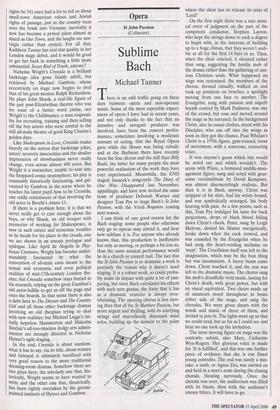Opera
Sublime Bach
Michael Tanner
There is an odd traffic going on these days between opera and non-operatic music. Some of the most enjoyable experi- ences of opera I have had in recent years, and not only thanks to the fact that no intrusive and arrogant producer was involved, have been the concert perfor- mances, sometimes involving a moderate amount of acting, that the Royal Opera gave while the House was being rebuilt; and at the Barbican there have recently been the fine Alceste and the still finer Billy Budd, the latter for many people the most powerful realisation of the work they have ever experienced. Meanwhile, the ENO staged Janacek's song-cycle The Dial)? of One Who Disappeared last November, appallingly; and have now invited the same team of producer Deborah Warner and designer Tom Pye to stage Bach's St John Passion, with the Verdi Requiem coming next season.
I can think of one good reason for the Bach staging: some people who otherwise only go to operas may attend it, and hear how sublime it is. For anyone who already knows that, this production is inoffensive but only as moving, or perhaps a bit less so, than the same musical performance would be in a church or concert hall. The fact that the St John Passion is so dramatic a work is precisely the reason why it doesn't need staging. It is a robust work, so could proba- bly make its impact with quite a lot of tam- pering, but since Bach calculated his effects with such sure genius, the force that it has as a dramatic oratorio is always over- whelming. The opening chorus is less mov- ing than that of the St Matthew Passion, but more urgent and thrilling, with its scurrying strings and marvellously dissonant wind solos, building up the tension to the point where the choir has to release its cries of 'Lord!'
On the first night there was a rare musi- cal error of judgment on the part of the competent conductor, Stephen Layton, who kept the strings down to such a degree to begin with, in the interests of building up to a huge climax, that they weren't audi- ble at all for the first 14 bars or so. Then, when the choir entered, it shouted rather than sang, suggesting the hostile mob of the drama rather than the gathering of anx- ious Christian souls. What happened on stage was restrained: the members of the chorus, dressed casually, walked on and took up positions on benches, a spotlight moving from one face to another. The Evangelist, sung with passion and superb breath control by Mark Padmore, was one of the crowd, but rose and moved around the stage as he narrated. In the background Christ, also in casual clothes, stood with his Disciples, who ran off into the wings as soon as they got the chance. Paul Whelan's Christ is a 1970s figure, gym-trained, loose of movement, with a sonorous, reassuring voice.
It was anyone's guess which bits would be acted out and which wouldn't. The scene with Pilate, a bemused middle-man- agement figure, sung and acted with grue- some verisimilitude by David Kempster, was almost disconcertingly realistic. But then it is in Bach, anyway. Christ was stripped of his shirt, had his wrists bound, and was symbolically scourged, his body heaving with pain. At a few points, such as this, Tom Pye indulged his taste for back projections, drops of black blood falling down Christ's cheek. Peter, sung by Leigh Melrose, denied his Master energetically, broke down when the cock crowed, and was consoled by the Evangelist when he had sung the heart-rending melisma on 'wept'. The Crucifixion itself was left to the imagination, which may be the best thing but was inconsistent. A heavy beam came down, Christ touched it, and the rest was left to the dramatic music. The chorus sang the mob's dreadfully vivid music, lusting for Christ's death, with great power, but with no visual equivalent. Two choirs made up of amateurs stood throughout in boxes either side of the stage, and sang the chorales. We were given sheets with the words and music of three of them, and invited to join in. The lights went up so that we could read, but so far as I could see and hear no one took up the invitation.
The most moving figure on stage was the contralto soloist, also Mary, Catherine Wyn-Rogers. Her glorious voice is made for 'It is fulfilled', and this was one further piece of evidence that she is our finest young contralto. The end was surely a mis- take: a lamb, or Agnus Dei, was carried on and held in a man's arms during the closing chorale, bleating nervously. Once the chorale was over, the auditorium was filled with its bleats, then with the audience's uneasy titters. It will have to go.


































































 Previous page
Previous page